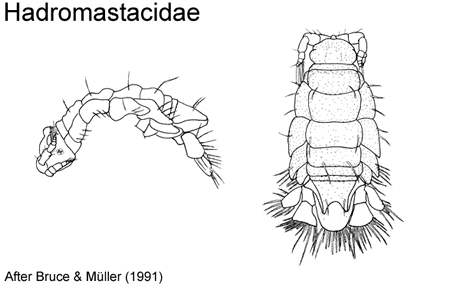 |
||||||
|
|
|
|
|
|
Australian Isopoda: FamiliesS.J. Keable, G.C.B. Poore & G.D.F. WilsonHadromastacidae Bruce & Müller, 1991 Hadromastacidae Bruce & Müller, 1991: 52. Description. Body. Body shape without loss or gross modification of appendages on one side of the body; in dorsal view without peduncular articles of antenna 1 or 2 contiguous with coxal margins. Head. Head capable of lateral rotation (off-set from pereonite 1). Antenna 1 inserting on head anteriorly and/or dorsally to antenna 2, minute or well developed; not as follows: reduced to 2 articles with second article expanded and scalloped. Antenna 2 well developed. Mouthparts not forming suctorial cone or proboscis. Mandible not projecting anteriorly and together forceps-like; palp present. Pereon. Pereonites 6-7 pereonite 7 distinct dorsally, free. Coxae extending ventrally and laterally to overhang the coxa-basis articulation of the pereopods. Coxa 1 and pereonite 1 distinctly separated by suture line. Pereopods 6-7 pairs readily apparent; 1-3 or 1-7 not prehensile. Pereopods 5-7 without flattened setose articles andor dactyls modified or absent. Pleon / Pleotelson. Pleonites and pleotelson not arranged as follows: pleonites 1-5 fused but with conspicuous lateral sutures, pleotelson fused to pleonites 1-5; pleonites 1-5 fused but with conspicuous lateral sutures, pleotelson not fused to pleonites 1-5; pleonites 1-5 fused without conspicuous sutures, pleotelson not fused to pleonites 1-5; pleonites 2-5 fused but with partial (usually lateral) sutures, pleotelson wholly or partly fused with pleonites 2-5; pleonites 3-5 fused without lateral sutures, pleotelson fused with pleonites 3-5, pleonites 1 and 2 free but may be only small rings or cuticular bars visible ventrally. Pleonite 5 subequal to or shorter than any of pleonites 1-4. Pleopods 5 pairs present. Pleopod 2 of males not consisting of an enlarged peduncle with a geniculate endopod and a small muscular exopod. Uropods positioned proximally on pleotelson; distinct from pleopods, not forming operculum over pleopodal chamber (although may be folded ventrally below pleotelson). Peduncle not forming an elongate clavate article with rami reduced or absent; not fused to endopod. Rami inserting on peduncle in widely separated positions. Endopod present, not claw-like (acute and recurved) andor posteroventral in position. Exopod not folded dorsally over pleotelson. Distribution and generic composition. See Kensley et al. (1996).
Cite this publication as: 'S.J. Keable, G.C.B. Poore & G.D.F. Wilson (2002 onwards). 'Australian Isopoda: Families. Version: 2 October 2002. https://crustacea.net'. |
|
|
|
|
|
|
|
|
|
Copyright © Australian Museum, 2002 - 2003
Australian Museum website
